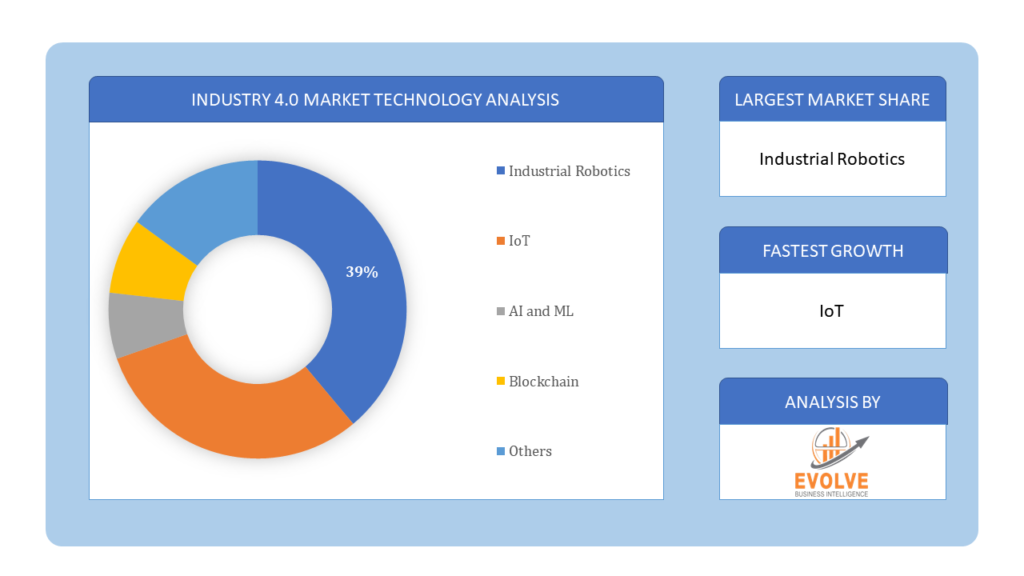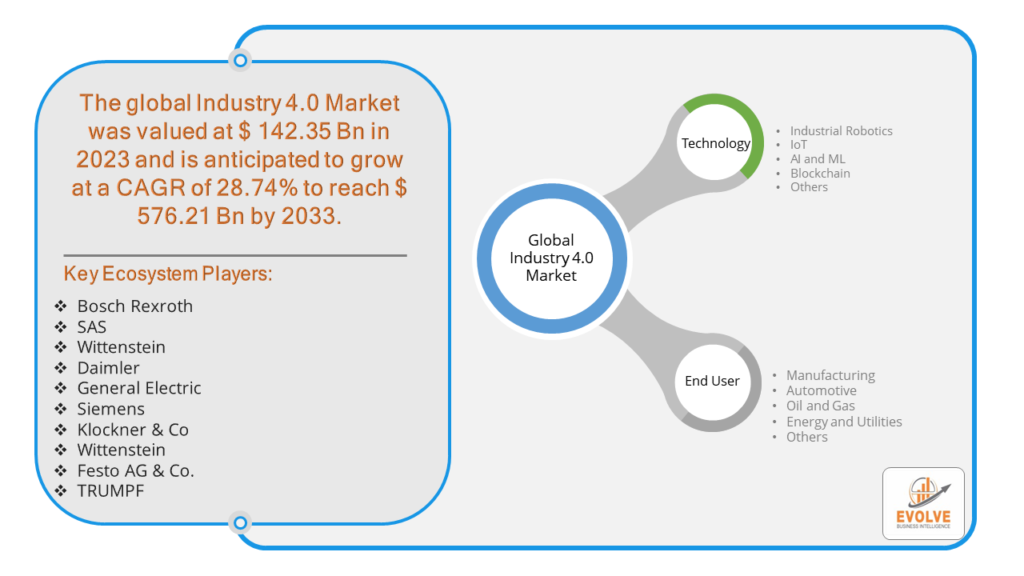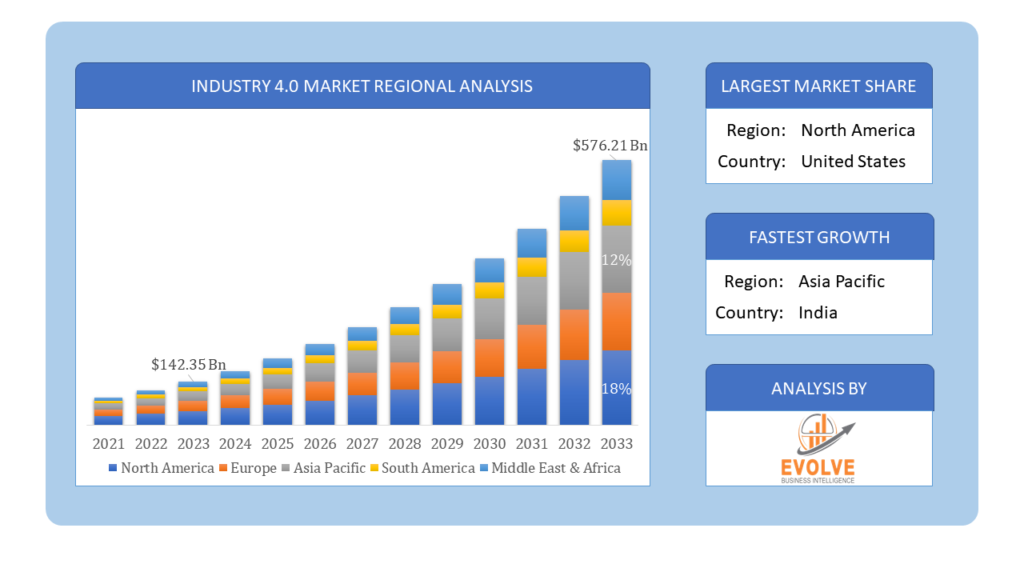Industry 4.0 Market Analysis and Global Forecast 2023-2033
$ 1,390.00 – $ 5,520.00Price range: $ 1,390.00 through $ 5,520.00
Industry 4.0 Market Research Report: Information By Technology (Industrial Robotics, IoT, AI and ML, Blockchain, Others), By End-user (Manufacturing, Automotive, Oil and Gas, Energy and Utilities, Others), and by Region — Forecast till 2033
Page: 170
Industry 4.0 Market Overview
The Industry 4.0 Market Size is expected to reach USD 576.21 Billion by 2033. The Industry 4.0 Market industry size accounted for USD 142.35 Billion in 2023 and is expected to expand at a compound annual growth rate (CAGR) of 28.74% from 2023 to 2033. The Industry 4.0 market refers to the market for technologies and services that enable the implementation of fourth industrial revolution (Industry 4.0) applications. Industry 4.0 is about using advanced digital technologies like artificial intelligence, industrial internet of things (IIoT), robotics, and big data analytics to transform manufacturing and other industries.
The Industry 4.0 market is expected to grow significantly in the coming years, driven by factors such as the increasing need for manufacturing efficiency, the growing demand for customization, and the rising adoption of advanced technologies.
Global Industry 4.0 Market Synopsis
The COVID-19 pandemic had a significant impact on the Industry 4.0 Market. The pandemic accelerated the digital transformation of industries as companies sought to adapt to disruptions and maintain operations remotely. Greater emphasis on digital supply chain solutions to enhance visibility, predictability, and responsiveness. Increased use of AI and machine learning for predictive maintenance to prevent unplanned downtime and extend equipment life. Growing need for workforce upskilling and reskilling to handle advanced Industry 4.0 technologies. Adoption of remote work practices for non-essential roles, supported by digital collaboration tools and platforms. Despite initial disruptions, the Industry 4.0 Market experienced growth as companies invested in digital solutions to enhance resilience and efficiency. Factories increasingly implemented smart manufacturing solutions to adapt to changing demand patterns and labor shortages. Companies are likely to continue investing in Industry 4.0 technologies to build more resilient and agile operations. Increased focus on research and development to address new challenges and leverage opportunities presented by the pandemic.
Industry 4.0 Market Dynamics
The major factors that have impacted the growth of Industry 4.0 Market are as follows:
Drivers:
Ø Technological Advancements
The proliferation of IoT devices enables seamless connectivity and data exchange between machines, leading to smarter and more efficient industrial processes. AI and ML algorithms enhance predictive maintenance, quality control, and process optimization, making industrial operations more efficient and reliable. Advanced robotics and automation technologies reduce labor costs, increase precision, and improve production speed, driving their adoption in various industries. Leveraging big data analytics helps companies gain insights into their operations, optimize processes, and make data-driven decisions. Real-time data collection and analysis enable proactive maintenance and immediate response to operational issues.
Restraint:
- Perception of High Implementation Costs
The cost of implementing Industry 4.0 technologies, including hardware, software, and infrastructure, can be prohibitively high for many companies, particularly small and medium-sized enterprises (SMEs). Ongoing costs for maintenance, updates, and upgrades of Industry 4.0 systems can be significant, adding to the financial burden. Companies may be uncertain about the return on investment for Industry 4.0 technologies, leading to hesitancy in committing significant resources. The benefits of Industry 4.0 implementations may take time to materialize, resulting in a long payback period that can deter investment.
Opportunity:
⮚ Enhanced Operational Efficiency
Leveraging IoT, AI, and big data analytics to optimize industrial processes, reduce waste, and improve overall operational efficiency. Utilizing predictive maintenance techniques to anticipate equipment failures, minimize downtime, and extend the lifespan of machinery. Developing innovative products and services that incorporate smart technologies, creating new revenue streams and competitive advantages. Offering more customized and flexible products to meet specific customer demands, enabled by advanced manufacturing techniques like 3D printing. Implementing energy-efficient technologies and practices to reduce operational costs and environmental impact.
Industry 4.0 Market Segment Overview
By Technology
 Based on Technology, the market is segmented based on Industrial Robotics, IoT, AI and ML, Blockchain and Others. IoT represented the largest segment. Industrial IoT technology empowers industries to gather vast amounts of information from their production lines, supply chains, and logistics, facilitating data-driven decision-making and process optimization. IoT enables remote monitoring and control, allowing operators to adjust settings and troubleshoot issues without physical presence, which is particularly valuable in remote or hazardous environments.
Based on Technology, the market is segmented based on Industrial Robotics, IoT, AI and ML, Blockchain and Others. IoT represented the largest segment. Industrial IoT technology empowers industries to gather vast amounts of information from their production lines, supply chains, and logistics, facilitating data-driven decision-making and process optimization. IoT enables remote monitoring and control, allowing operators to adjust settings and troubleshoot issues without physical presence, which is particularly valuable in remote or hazardous environments.
By End User
Based on End User, the market segment has been divided into the Manufacturing, Automotive, Oil and Gas, Energy and Utilities and Others. Manufacturing segment dominant the market. Manufacturers across various domains, including automotive, aerospace, electronics, and consumer goods, are embracing Industry 4.0 to gain a competitive edge. Smart factories equipped with sensors, automation, and data analytics enable real-time monitoring of machinery and processes. This empowers manufacturers to identify and rectify inefficiencies, minimize downtime, and enhance product quality, ultimately reducing production costs.
Global Industry 4.0 Market Regional Analysis
Based on region, the global Industry 4.0 Market has been divided into North America, Europe, Asia-Pacific, the Middle East & Africa, and Latin America. North America is projected to dominate the use of the Industry 4.0 Market followed by the Asia-Pacific and Europe regions.
 Industry 4.0 North America Market
Industry 4.0 North America Market
North America holds a dominant position in the Industry 4.0 Market. North America, particularly the United States, is a leader in the development and implementation of Industry 4.0 technologies due to strong technological infrastructure and innovation capabilities. Government initiatives and funding programs, such as the Manufacturing USA network, support the adoption of advanced manufacturing technologies. The automotive, aerospace, and healthcare sectors are prominent adopters of Industry 4.0 technologies in this region. High implementation costs and cybersecurity concerns are notable challenges.
Industry 4.0 Asia-Pacific Market
The Asia-Pacific region has indeed emerged as the fastest-growing market for the Industry 4.0 Market industry. The Asia-Pacific region, led by China, Japan, and South Korea, is experiencing rapid growth in the adoption of Industry 4.0 technologies. The region is a global manufacturing hub with a focus on electronics, automotive, and consumer goods industries. Variability in technological infrastructure and skills gaps are notable challenges.
Competitive Landscape
The global Industry 4.0 Market is highly competitive, with numerous players offering a wide range of software solutions. The competitive landscape is characterized by the presence of established companies, as well as emerging startups and niche players. To increase their market position and attract a wide consumer base, the businesses are employing various strategies, such as product launches, and strategic alliances.
Prominent Players:
- Bosch Rexroth
- SAS
- Wittenstein
- Daimler
- General Electric
- Siemens
- Klockner & Co
- Wittenstein
- Festo AG & Co.
- TRUMPF
Key Development
In February 2023, Schneider Electric SE launched Industrial Digital Transformation Consulting and Deployment Service. The service is designed to help industrial enterprises achieve future-ready, innovative, sustainable, and effective end-to-end digital transformation.
In April 2024, Dell, Hyundai, and Intel are collaborating to enhance Industry 4.0 AI capabilities by integrating NativeEdge and using edge AI and real-time data to optimize production operations. Scope of the Report
Global Industry 4.0 Market, by Technology
- Industrial Robotics
- IoT
- AI and ML
- Blockchain
- Others
Global Industry 4.0 Market, by End User
- Manufacturing
- Automotive
- Oil and Gas
- Energy and Utilities
- Others
Global Industry 4.0 Market, by Region
- North America
- US
- Canada
- Mexico
- Europe
- UK
- Germany
- France
- Italy
- Spain
- Benelux
- Nordic
- Rest of Europe
- Asia Pacific
- China
- Japan
- South Korea
- Indonesia
- Austalia
- Malaysia
- India
- Rest of Asia Pacific
- South America
- Brazil
- Argentina
- Rest of South America
- Middle East & Africa
- Saudi Arabia
- UAE
- Egypt
- South Africa
- Rest of Middle East & Africa
| Parameters | Indicators |
|---|---|
| Market Size | 2033: $576.21 Billion/strong> |
| CAGR | 28.74% CAGR (2023-2033) |
| Base year | 2022 |
| Forecast Period | 2023-2033 |
| Historical Data | 2021 |
| Report Coverage | Revenue Forecast, Competitive Landscape, Growth Factors, and Trends |
| Key Segmentations | Technology, End User |
| Geographies Covered | North America, Europe, Asia-Pacific, Latin America, Middle East, Africa |
| Key Vendors | Bosch Rexroth, SAS, Wittenstein, Daimler, General Electric, Siemens, Klockner & Co, Wittenstein, Festo AG & Co. and TRUMPF |
| Key Market Opportunities | • Enhanced Operational Efficiency • Innovation and Product Development |
| Key Market Drivers | • Technological Advancements • Data Utilization |
REPORT CONTENT BRIEF:
- High-level analysis of the current and future Industry 4.0 Market trends and opportunities
- Detailed analysis of current market drivers, restraining factors, and opportunities in the future
- Industry 4.0 Market historical market size for the year 2021, and forecast from 2023 to 2033
- Industry 4.0 Market share analysis at each product level
- Competitor analysis with detailed insight into its product segment, Government & Defense strength, and strategies adopted.
- Identifies key strategies adopted including product launches and developments, mergers and acquisitions, joint ventures, collaborations, and partnerships as well as funding taken and investment done, among others.
- To identify and understand the various factors involved in the global Industry 4.0 Market affected by the pandemic
- To provide a detailed insight into the major companies operating in the market. The profiling will include the Government & Defense health of the company’s past 2-3 years with segmental and regional revenue breakup, product offering, recent developments, SWOT analysis, and key strategies.
Press Release

Global Pharmaceutical Manufacturing Market to Reach $1.38 Trillion by 2035 with 7.35% CAGR, New Research Shows

The Global Mammography Market Is Estimated To Record a CAGR of Around 10.29% During The Forecast Period

Glue Stick Market to Reach USD 2.35 Billion by 2034

Podiatry Service Market to Reach USD 11.88 Billion by 2034

Microfluidics Technology Market to Reach USD 32.58 Billion by 2034

Ferric Chloride Market to Reach USD 10.65 Billion by 2034

Family Practice EMR Software Market to Reach USD 21.52 Billion by 2034

Electric Hairbrush Market to Reach USD 15.95 Billion by 2034

Daily Bamboo Products Market to Reach USD 143.52 Billion by 2034

Cross-border E-commerce Logistics Market to Reach USD 112.65 Billion by 2034
Frequently Asked Questions (FAQ)
1.What is the study period of this market?
- The study period of the global Industry 4.0 Market is 2021- 2033
2.What is the growth rate of the global Industry 4.0 Market?
- The global Industry 4.0 Market is growing at a CAGR of 28.74% over the next 10 years
3.Which region has the highest growth rate in the market of Industry 4.0 Market?
- Asia Pacific is expected to register the highest CAGR during 2023-2033
4.Which region has the largest share of the global Industry 4.0 Market?
- North America holds the largest share in 2022
5.Who are the key players in the global Industry 4.0 Market?
- Bosch Rexroth, SAS, Wittenstein, Daimler, General Electric, Siemens, Klockner & Co, Wittenstein, Festo AG & Co. and TRUMPF. are the major companies operating in the market.
6.Do you offer Post Sale Support?
- Yes, we offer 16 hours of analyst support to solve the queries
7.Do you sell particular sections of a report?
Yes, we provide regional as well as country-level reports. Other than this we also provide a sectional report. Please get in contact with our sales representatives
Table of Content
Chapter 1. Executive Summary Chapter 2. Scope Of The Study 2.1. Market Definition 2.2. Scope Of The Study 2.2.1. Objectives of Report 2.2.2. Limitations 2.3. Market Structure Chapter 3. Evolve BI Methodology Chapter 4. Market Insights and Trends 4.1. Supply/ Value Chain Analysis 4.1.1. Raw End Users Providers 4.1.2. Manufacturing Process 4.1.3. Distributors/Retailers 4.1.4. End-Use Industry 4.2. Porter’s Five Forces Analysis 4.2.1. Threat Of New Entrants 4.2.2. Bargaining Power Of Buyers 4.2.3. Bargaining Power Of Suppliers 4.2.4. Threat Of Substitutes 4.2.5. Industry Rivalry 4.3. Impact Of COVID-19 on the Industry 4.0 Market 4.3.1. Impact on Market Size 4.3.2. End-Use Industry Trend, Preferences, and Budget Impact 4.3.3. Regulatory Framework/Government Policies 4.3.4. Key Players' Strategy to Tackle Negative Impact 4.3.5. Opportunity Window 4.4. Technology Overview 12.28. Macro factor 4.6. Micro Factor 4.7. Demand Supply Gap Analysis of the Industry 4.0 Market 4.8. Import Analysis of the Industry 4.0 Market 4.9. Export Analysis of the Industry 4.0 Market Chapter 5. Market Dynamics 5.1. Introduction 5.2. DROC Analysis 5.2.1. Drivers 5.2.2. Restraints 5.2.3. Opportunities 5.2.4. Challenges 5.3. Patent Analysis 5.4. Industry Roadmap 5.5. Parent/Peer Market Analysis Chapter 6. Global Industry 4.0 Market, By Technology 6.1. Introduction 6.2. Industrial Robotics 6.3. IoT 6.4. AI and ML 6.5. Blockchain 6.6. Others Chapter 7. Global Industry 4.0 Market, By End User 7.1. Introduction 7.2. Food service industry 7.3. Retail users Chapter 8. Global Industry 4.0 Market, By Region 8.1. Introduction 8.2. North America 8.2.1. Introduction 8.2.2. Driving Factors, Opportunity Analyzed, and Key Trends 8.2.3. Market Size and Forecast, By Country, 2023-2033 8.2.4. Market Size and Forecast, By Product Type, 2023-2033 8.2.5. Market Size and Forecast, By End User, 2023-2033 8.2.6. US 8.2.6.1. Introduction 8.2.6.2. Driving Factors, Opportunity Analyzed, and Key Trends 8.2.6.3. Market Size and Forecast, By Product Type, 2023-2033 8.2.6.4. Market Size and Forecast, By End User, 2023-2033 8.2.7. Canada 8.2.7.1. Introduction 8.2.7.2. Driving Factors, Opportunity Analyzed, and Key Trends 8.2.7.4. Market Size and Forecast, By Product Type, 2023-2033 8.2.7.5. Market Size and Forecast, By End User, 2023-2033 8.3. Europe 8.3.1. Introduction 8.3.2. Driving Factors, Opportunity Analyzed, and Key Trends 8.3.3. Market Size and Forecast, By Country, 2023-2033 8.3.4. Market Size and Forecast, By Product Type, 2023-2033 8.3.5. Market Size and Forecast, By End User, 2023-2033 8.3.6. Germany 8.3.6.1. Introduction 8.3.6.2. Driving Factors, Opportunity Analyzed, and Key Trends 8.3.6.3. Market Size and Forecast, By Product Type, 2023-2033 8.3.6.4. Market Size and Forecast, By End User, 2023-2033 8.3.7. France 8.3.7.1. Introduction 8.3.7.2. Driving Factors, Opportunity Analyzed, and Key Trends 8.3.7.3. Market Size and Forecast, By Product Type, 2023-2033 8.3.7.4. Market Size and Forecast, By End User, 2023-2033 8.3.8. UK 8.3.8.1. Introduction 8.3.8.2. Driving Factors, Opportunity Analyzed, and Key Trends 8.3.8.3. Market Size and Forecast, By Product Type, 2023-2033 8.3.8.4. Market Size and Forecast, By End User, 2023-2033 8.3.9. Italy 8.3.9.1. Introduction 8.3.9.2. Driving Factors, Opportunity Analyzed, and Key Trends 8.3.9.3. Market Size and Forecast, By Product Type, 2023-2033 8.3.9.4. Market Size and Forecast, By End User, 2023-2033 8.3.11. Rest Of Europe 8.3.11.1. Introduction 8.3.11.2. Driving Factors, Opportunity Analyzed, and Key Trends 8.3.11.3. Market Size and Forecast, By Product Type, 2023-2033 8.3.11.4. Market Size and Forecast, By End User, 2023-2033 8.4. Asia-Pacific 8.4.1. Introduction 8.4.2. Driving Factors, Opportunity Analyzed, and Key Trends 8.4.3. Market Size and Forecast, By Country, 2023-2033 8.4.4. Market Size and Forecast, By Product Type, 2023-2033 8.12.28. Market Size and Forecast, By End User, 2023-2033 8.4.6. China 8.4.6.1. Introduction 8.4.6.2. Driving Factors, Opportunity Analyzed, and Key Trends 8.4.6.3. Market Size and Forecast, By Product Type, 2023-2033 8.4.6.4. Market Size and Forecast, By End User, 2023-2033 8.4.7. India 8.4.7.1. Introduction 8.4.7.2. Driving Factors, Opportunity Analyzed, and Key Trends 8.4.7.3. Market Size and Forecast, By Product Type, 2023-2033 8.4.7.4. Market Size and Forecast, By End User, 2023-2033 8.4.8. Japan 8.4.8.1. Introduction 8.4.8.2. Driving Factors, Opportunity Analyzed, and Key Trends 8.4.8.3. Market Size and Forecast, By Product Type, 2023-2033 8.4.8.4. Market Size and Forecast, By End User, 2023-2033 8.4.9. South Korea 8.4.9.1. Introduction 8.4.9.2. Driving Factors, Opportunity Analyzed, and Key Trends 8.4.9.3. Market Size and Forecast, By Product Type, 2023-2033 8.4.9.4. Market Size and Forecast, By End User, 2023-2033 8.4.10. Rest Of Asia-Pacific 8.4.10.1. Introduction 8.4.10.2. Driving Factors, Opportunity Analyzed, and Key Trends 8.4.10.3. Market Size and Forecast, By Product Type, 2023-2033 8.4.10.4. Market Size and Forecast, By End User, 2023-2033 8.5. Rest Of The World (RoW) 8.5.1. Introduction 8.5.2. Driving Factors, Opportunity Analyzed, and Key Trends 8.5.3. Market Size and Forecast, By Product Type, 2023-2033 8.5.4. Market Size and Forecast, By End User, 2023-2033 Chapter 9. Company Landscape 9.1. Introduction 9.2. Vendor Share Analysis 9.3. Key Development Analysis 9.4. Competitor Dashboard Chapter 10. Company Profiles 10.1. Bosch Rexroth 10.1.1. Business Overview 10.1.2. Government & Defense Analysis 10.1.2.1. Government & Defense – Existing/Funding 10.1.3. Product Portfolio 10.1.4. Recent Development and Strategies Adopted 10.1.5. SWOT Analysis 10.2. SAS 10.2.1. Business Overview 10.2.2. Government & Defense Analysis 10.2.2.1. Government & Defense – Existing/Funding 10.2.3. Product Portfolio 10.2.4. Recent Development and Strategies Adopted 10.2.5. SWOT Analysis 10.3. Wittenstein 10.3.1. Business Overview 10.3.2. Government & Defense Analysis 10.3.2.1. Government & Defense – Existing/Funding 10.3.3. Product Portfolio 10.3.4. Recent Development and Strategies Adopted 10.3.5. SWOT Analysis 10.4. Daimler 10.4.1. Business Overview 10.4.2. Government & Defense Analysis 10.4.2.1. Government & Defense – Existing/Funding 10.4.3. Product Portfolio 10.4.4. Recent Development and Strategies Adopted 10.12.28. SWOT Analysis 10.5. General Electric 10.5.1. Business Overview 10.5.2. Government & Defense Analysis 10.5.2.1. Government & Defense – Existing/Funding 10.5.3. Product Portfolio 10.5.4. Recent Development and Strategies Adopted 10.5.5. SWOT Analysis 10.6. Siemens 10.6.1. Business Overview 10.6.2. Government & Defense Analysis 10.6.2.1. Government & Defense – Existing/Funding 10.6.3. Product Portfolio 10.6.4. Recent Development and Strategies Adopted 10.6.5. SWOT Analysis 10.7. Klockner & Co 10.7.1. Business Overview 10.7.2. Government & Defense Analysis 10.7.2.1. Government & Defense – Existing/Funding 10.7.3. Product Portfolio 10.7.4. Recent Development and Strategies Adopted 10.7.5. SWOT Analysis 10.8 Wittenstein 10.8.1. Business Overview 10.8.2. Government & Defense Analysis 10.8.2.1. Government & Defense – Existing/Funding 10.8.3. Product Portfolio 10.8.4. Recent Development and Strategies Adopted 10.8.5. SWOT Analysis 10.9 Festo AG & Co. 10.9.1. Business Overview 10.9.2. Government & Defense Analysis 10.9.2.1. Government & Defense – Existing/Funding 10.9.3. Product Portfolio 10.9.4. Recent Development and Strategies Adopted 10.9.5. SWOT Analysis 10.10. TRUMPF 10.10.1. Business Overview 10.10.2. Government & Defense Analysis 10.10.2.1. Government & Defense – Existing/Funding 10.10.3. Product Portfolio 10.10.4. Recent Development and Strategies Adopted 10.10.5. SWOT Analysis
Connect to Analyst
Research Methodology








